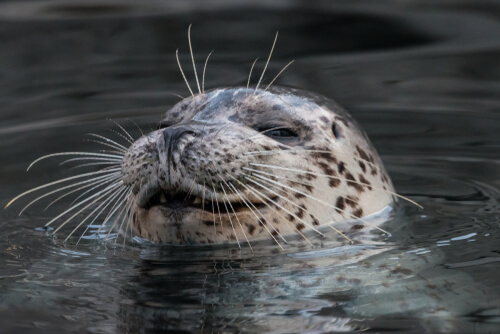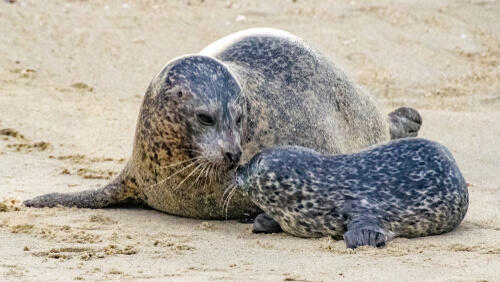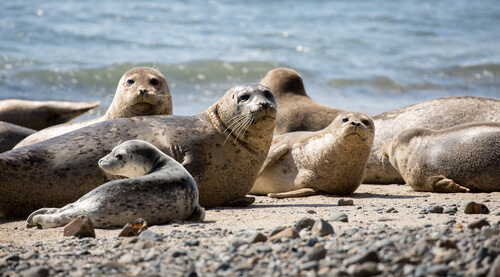
| Kingdom | Animalia |
| Phylum | Chordata |
| Class | Mammalia |
| Order | Carnivora |
| Family | Phocidae |
| Genus | Phoca |
| Species | P. vitulina |
| Niche | Carnivorous marine mammal |
| Length | 5-6 ft (1.7-1.9 m) |
| Weight | Up to 300 lb (140 kg) |
| Lifespan | 25-30 years |
| Social Structure | Largely solitary |
| Conservation Status | Least concern |
| Preferred Habitat | Temperate coastal |
| Average Number of Young | 1 |
| Main Prey Species | Fish |
| Predators | Sharks, orcas, sea lions, bears, wolves, coyotes, eagles, humans |
The Basics
The harbor seal is a carnivorous marine mammal. It is the pinniped with the largest geographical range reaching along the west and east coast of North America and the west coast of Europe.
General
Harbor seals grow to 5-6 feet I length and can weigh up to 300 pounds. They have large, round heads lacking external ears. They have distinctive V-shaped nostrils surrounded by whiskers and their skin appears smooth and ranges in color from grey to nearly white and is often mottled or spotted, depending on the subspecies or population. Harbor seals also have long, flat flippers that combine with their hind limbs to allow them excellent swimming ability. However, they are not particularly adept at moving onshore and will normally not stray very far from the water’s edge while resting onshore.

Habitat and Range
The harbor seal is the most widely distributed species of pinniped. It is found along coastlines in both temperate and arctic regions of the Northern Hemisphere. This includes the northern Atlantic from the French coast northwards towards the Barents Sea as well as the east coast of North America. In the Pacific, it can be found along the west coast of North America from Baja California northwards to the Arctic Ocean.

Harbor seals normally prefer coastal habitats within this range and can often be observed in shallow waters in marinas, estuaries, and lagoons. They will often haul out of the water in some areas to rest and nurse their young. Here, they form loosely formed social groups largely for defense while on land but are largely solitary animals otherwise.
Prey and Predators
The harbor seal is carnivorous, feeding mostly on fish and various invertebrate species. They may travel up to 30 miles in search of feeding grounds, even traveling up freshwater rivers at times in pursuit of species such as salmon. Harbor seals have been known to dive to depths of over 1,500 ft in search of prey. They also enjoy shad, anchovy, sea bass, herring, mackerel, cod, and more. When fish isn’t available they may also eat invertebrates such as various crabs and mollusks such as the giant Pacific octopus.
The harbor seal is susceptible to predation by several species. One of its most common predators are orcas, which will hunt them in the water but will also find ways to push themselves onto shorelines at times to snatch helpless pups in particular. Various shark species will feed on pups if given the opportunity, while some species such as the Great White Shark are capable of hunting adult seals, often breaching the water’s surface and jumping high out of it in a high-speed pursuit of their prey. Sea lions will also hunt seals, particularly small ones.
On land, additional threats include bears, wolves, coyotes, and eagles, all of which may especially target newborn pups. Most harbor seals will use familiar haul-out sites where possible, often being chosen apparently for their isolation from many such terrestrial predators. Seals are also hunted by humans for various purposes including their blubber and their pelts. However, throughout much of its range, sealing is now an illegal practice.
Reproduction
Following copulation, the gestation period lasts approximately nine months. After this, she gives birth to a single pup. Although they are normally born on land, they are largely developed – weighing roughly 35 pounds at birth – and are capable of swimming and diving within a few hours. Mothers will nurse and care for their pups alone, weaning them after about 4-6 weeks. Most individuals live for about 20-30 years, although captive individuals have been known to live longer.
Conservation Status
The current global population of harbor seals is estimated to be between 350,000 and 500,000 individuals. However, in some areas where their habitat is threatened, certain subspecies remain are threatened. As a whole, the species is currently listed as ‘Least Concern’ on the IUCN Red List of Threatened Species.
Fun Facts about the Harbor Seal!
Harbor seals are ubiquitous throughout their range and are often observed by humans. Their playful nature makes them a popular species in large aquaria as well, as they are an interesting and fascinating species to explore.

Fat is a Friend
Heat dissipates quickly in water, and the harbor seal spends most of its time in cold waters. To remain warm in this environment, the species has evolved thick layers of subcutaneous fat that provides both energy when food is sparse as well as insulation, giving them a resting metabolism rate 1.7 to 2.2 times higher than other terrestrial mammals their size. In order to build and maintain this fat layer, seals must gorge themselves when possible to run a calorie surplus. This allows them to survive during times of reduced food availability as well, living off of their fat reserves instead.

Holding its Breath
The harbor seal is well adapted to its marine environment. Besides its thick layer of blubber that keeps it warm, it also has webbed flippers that allow them to swim quickly and efficiently. They are also capable of diving to extraordinary depths for an air-breathing mammal, reaching up to 1,500 feet at times.
Rather than exhaling before diving, seals and other marine mammals keep their lungs full and stop breathing underwater. As their heart rate slows, they conserve oxygen and reduce the build-up of lactic acid in their muscles that would otherwise occur without these adaptations. Harbor seals also have narrow nostrils that easily close during swimming, yet another evolutionary adaptation that allows them to live such a marine-based existence.
Same Same but Different
Although harbor seals are generally monomorphic, there are various subspecies in various regions that differ slightly, mostly in the color of their skin. Individuals with a yellow-cream coat covered in small pale ringed black spots are characterized as “light phase”. “Dark phase” seals have a black coat containing dark spots with light rings found primarily on their top side. Their varying color patterns are a result of differing concentrations of melanocytes in the epidermis. This may be in part due to variations in the availability of different types of food in varying regions throughout their range.
